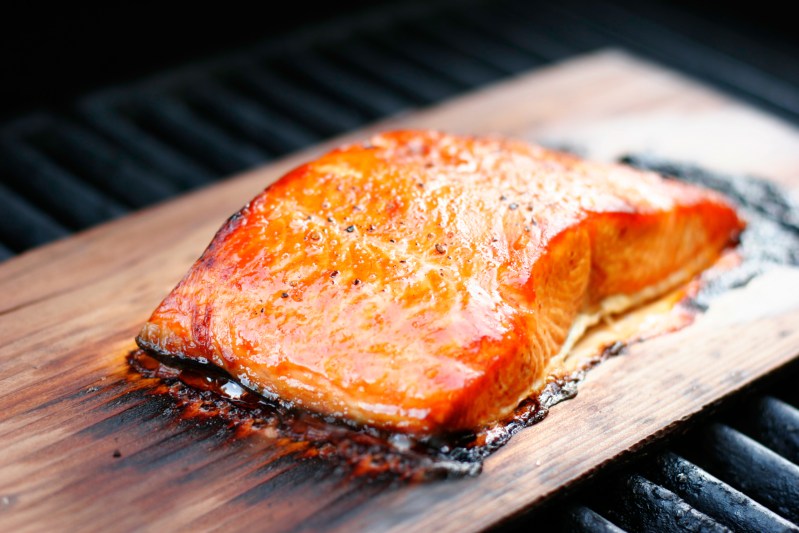Love salmon but hate how dry and rubbery it gets when reheated? You’re not alone. Whether you’re saving leftovers from last night’s gourmet dinner or prepping meals for the week, reheating salmon the right way can make all the difference. Here’s exactly how to keep your salmon juicy, flavorful, and satisfying — no matter what method you use.
The best ways to reheat salmon

If you’re into weekly meal prep or if you made too much salmon to eat in one sitting, you may have found yourself wondering how to reheat salmon. Let us help you out with some nifty ways to reheat your oceanic meal.
| Method | Time | Best For | Tips |
|---|---|---|---|
| Oven | 15-20 min | Preserving texture | Low temp, foil cover |
| Stovetop | 4-5 min | Quick, crispy edges | Use oil or butter |
| Air Fryer | 5 min | Fast & crispy | Parchment paper helps |
| Microwave | 1-2 min | Convenience | Low power, add moisture |
| Smoked Salmon | 5-8 min | Enhancing smoky flavor | Low heat, olive oil or butter |
How to reheat salmon in the oven
While this method takes a little longer, it is the best way to ensure that you preserve the integrity of the salmon flesh when reheating. The secret is using a low temperature and sticking to the cooking time.
- Preheat your oven to 275 degrees Fahrenheit.
- Squeeze half a lemon or rub a tablespoon of olive oil overtop of your salmon.
- Fold a piece of baking foil loosely over the salmon.
- Place the salmon on a baking tray.
- Bake the salmon for 15 minutes.
- Check to see if the salmon has heated through to an internal temperature of 145 degrees Fahrenheit. If not, cook for an additional 5 minutes.
- Enjoy!
How to reheat salmon on a stovetop
You can also reheat salmon on the stovetop, which is a bit different from the oven, as described above.
- Heat a pan over medium-low heat with a tablespoon of extra virgin olive oil or butter.
- Add the leftover salmon to the pan.
- Cook it on the stovetop for 1 to 2 minutes per side, just until it’s heated through.
How to reheat salmon in an air fryer
An air fryer is a fantastic way to reheat salmon when you don’t want to heat the whole house by turning on the oven. It’s also a much quicker and very simple process.
- Set the air fryer to 360 degrees Fahrenheit.
- If your salmon has the skin intact, be sure to place the skin side down on a piece of parchment paper.
- Heat for 4 to 5 minutes or until salmon is heated through.
How to reheat salmon in the microwave
Microwave reheating is infamous for overcooking parts of a dish and undercooking others. It tends to be harsh on delicate meats like salmon; however, the convenience of a microwave cannot be beaten. It’s the most popular appliance for quick and easy reheating. Here lies the secret to reheating salmon in the microwave:
- Place salmon in a microwave-safe dish or bowl.
- Use a paper towel or a lid to keep moisture in the container and distribute heat effectively.
- If your salmon does not have a sauce or if you are not reheating the salmon with other sides like vegetables and rice, you want to ensure that there is sufficient moisture in the container. For dry salmon or if reheating with rice dishes, add a tablespoon of water, lemon juice, sauce, or broth to the container to prevent drying out.
- Set microwave power to a low setting — 30% or so will do.
- Microwave for 30 seconds.
- Remove the salmon, flip, or move with a fork and stir sides like rice and vegetables.
- Place back in the microwave for an additional 30 seconds.
How to reheat smoked salmon
Smoked salmon is a favorite for kitchens across the globe. Smoked salmon has already been cooked and infused with flavor during the smoking process. Reheating it requires extra care to avoid ruining its delicate texture and taste. If you are looking to keep these flavors when reheating the salmon, then this method is the best of the bunch.
- Preheat your oven to 325 degrees Fahrenheit.
- Place the salmon on a baking dish or sheet.
- Coat with a dash of olive oil or a teaspoon of butter.
- Warm the salmon for 5 minutes.
- Check to see if the salmon has warmed. The internal temperature should be around 145 degrees Fahrenheit.
- Cook for 2-3 minutes extra if the salmon needs further heating.
- Tuck in right away to enjoy the freshly heated flavors!
Additional tips

As mentioned, salmon can dry out easily when reheated. To prevent this, you can add moisture in a couple of ways. Place a small pat of butter or a squeeze of lemon juice on top of the fish before reheating. You can also add a splash of water or broth to the pan or other cooking device. Also, don’t blast the salmon with high heat. Reheat it slowly over low heat to avoid overcooking it.
Always refrigerate cooked salmon within two hours of cooking and consume within three days for the best quality and safety.
FAQs
Can you reheat salmon twice?
Yes, but do it gently and only if the salmon was stored properly. Reheating more than once increases the risk of drying out and food safety issues.
Is it safe to reheat salmon in the microwave?
Yes, but use low power and add moisture to prevent overcooking and smell.
Salmon is a delicious and nutritious meal. Reheating salmon doesn’t have to mean sacrificing flavor or texture. With these tips, you’ll never suffer through dry leftovers again.




